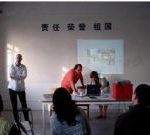Els Silvrants 4/12-2007
The chinese trademark: The chinese art market and its margins: A lecture by Els Silvrants
As China hits the international chart as most popular cultural destination, a dazzling amount of international artists, researchers and curators make their way to China’s cultural capitals. This gives rise to an unprecedented artistic mobility between China and the Western worlds sniffing, producing or copy-pasting the one after the project with a Chinese trademark.
However, are Beijing and Shanghai really the Berlin and New York’s of the 21st Century? Or is the Chinese government simply setting the stage for its creative potential to still the hunger of the international art market, while updating its own image?
Above all, China’s artistic landscape is work-in-progress. Chinese artists are struggling with their own identity and often lack the time and space to run trial and error as the market and the hype push for immediate results. Notions of “Chinese-ness” and “authenticity” become highly problematic as no artistic experiment inside the Chinese art communities can be isolated from the international attention both fuelling and funding its existence.
Moreover, hardly any local art structures and commodities are put in place: Beijing boasts over 300 theatres but not one has an artistic director let alone a year-round program. Museums are still partially handled by retired army officers and are only now slowly catching up. China based galleries are thriving businesses but as in any other place in the world, commerce and artistic integrity fight a constant battle, and even more so in a place lacking expertise and patience.
On the other hand, lack of context does offer an interesting playground to experiment with new forms of artistic, curatorial and organizational practice. It reveals the opportunity to re-think and re-configure traditional art structures. As China is reinventing every notion of development, we find ourselves in the fascinating position not only to discuss the way in which Chinese artists produce content on such short notice, but also how commodities are created to accommodate this process.
In China, it is the market that is producing the margins in which the independent scene operates. The Chinese government has understood that creative industries not only create revenue but also serve as an updated ideology, look at the Olympics. The ongoing emergence of “art with Chinese characteristics” and the context in which this takes place, therefore, makes us question the operational mode of the art scene from a global perspective. Great art is produced by exceptional individuals no matter where they come from, but will it be China providing us with the future blueprints of the lay-out of the global art landscape?
THEATRE IN MOTION (TIM) is a non-profit organization building context for the contemporary performing arts in China. TIM accommodates research, runs an international performing arts archive, organizes workshops and lectures, further contextualized with small-scale curatorial projects in and outside China.
TIM projects show that the contemporary performing arts can be more than a narrative on stage. Artists, dramaturges and curators are invited to reconfigure the traditional black box setting of the theatre, to develop alternative interfaces between audience and performer, to experiment with new strategies to collect dramaturgical information, to explore new insights on the relationship between performance and its social and urban environment.
TIM is part of beiLAB, a cross-disciplinary research platform uniting artists, architects and scientists with a research interest in the Chinese cultural, social and urban condition. BeiLAB provides researchers with a base camp in Beijing, gives ongoing research mobility more visibility with the Global Classroom lecture series while making information on past, present and future research in and on China more accessible through a virtual and physical archive project.
Els Silvrants holds a Master degree in Chinese studies. In 2004 she moved to Beijing where she works a an independent curator and artistic consultant on various projects and festivals before establishing TIM.
